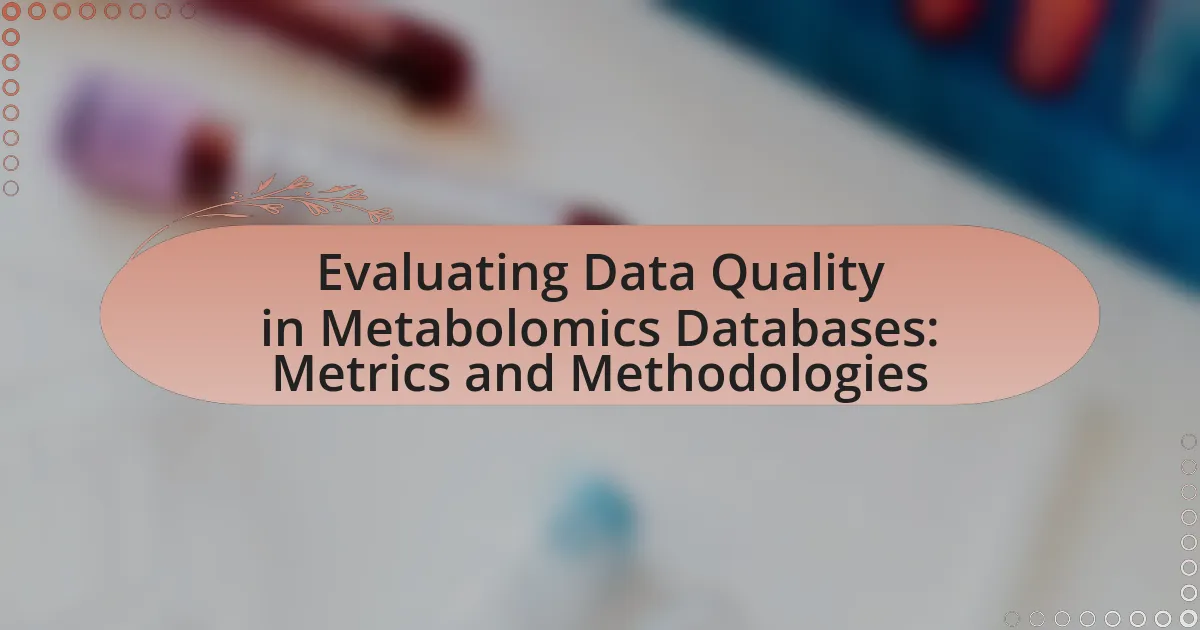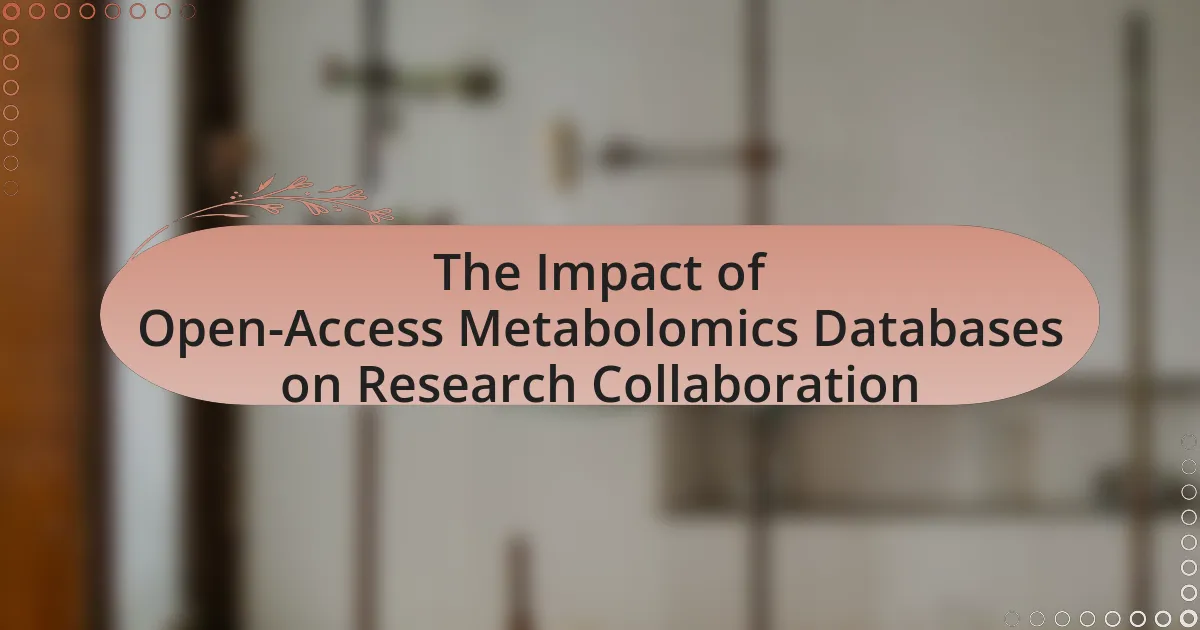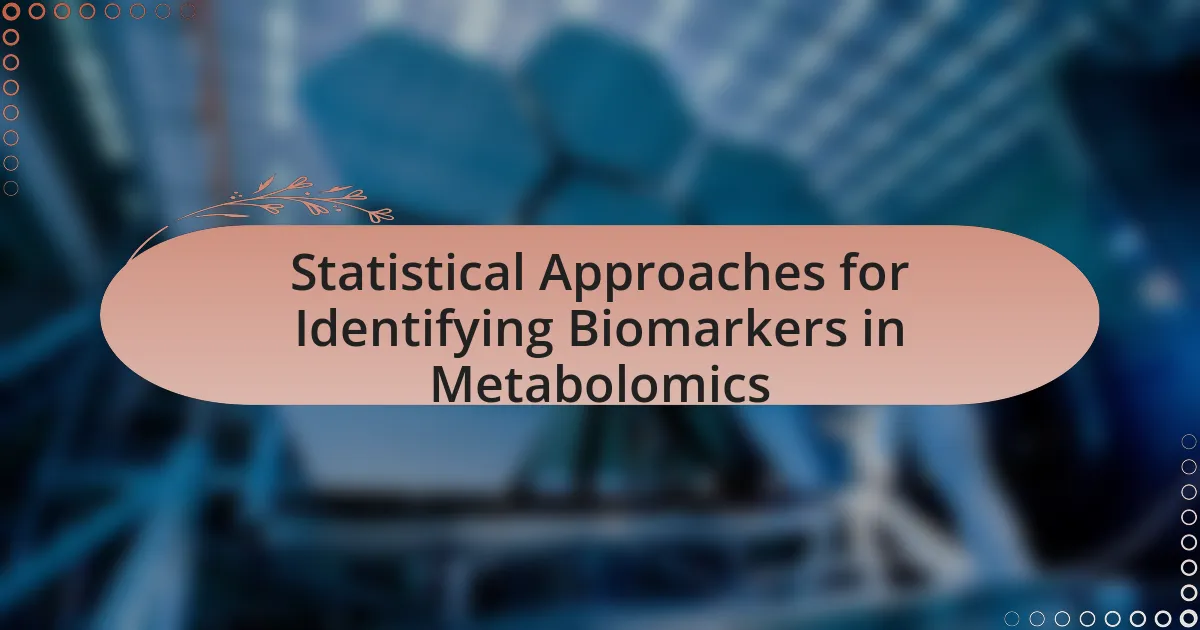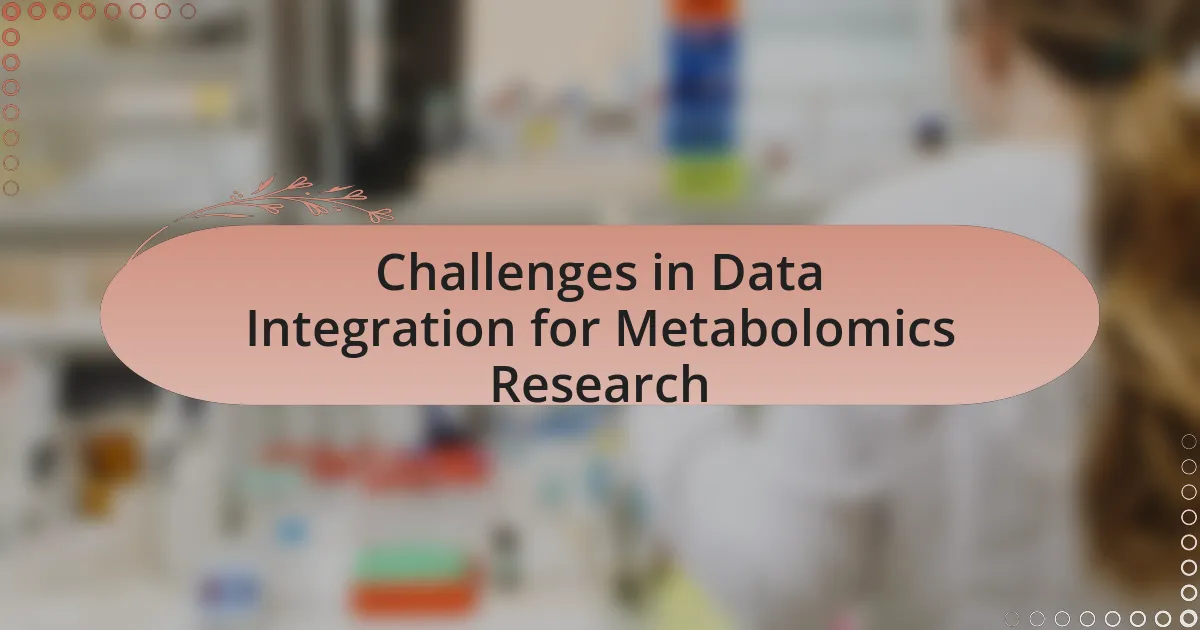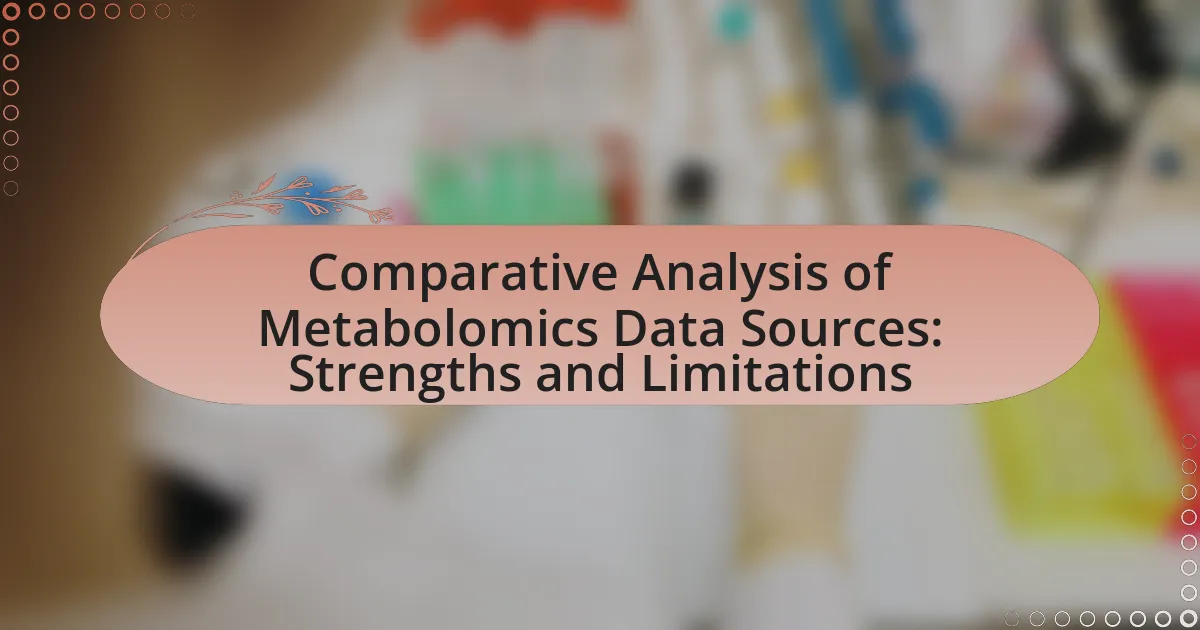Metabolomics is a crucial field that significantly impacts personalized medicine by providing insights into individual metabolic profiles, which inform tailored treatment strategies. This article explores how metabolomics enhances understanding of health, identifies key metabolites, and influences disease progression, ultimately facilitating precision therapies. It discusses current trends in metabolomics research, including technological advancements and emerging clinical applications, while addressing challenges such as data complexity and ethical considerations. The integration of metabolomics into clinical practice is emphasized, highlighting its potential to improve patient care through personalized treatment plans based on metabolic responses.
What is the impact of metabolomics on personalized medicine?
Metabolomics significantly enhances personalized medicine by providing detailed insights into metabolic profiles that can inform tailored treatment strategies. This field allows for the identification of biomarkers associated with specific diseases, enabling clinicians to customize therapies based on individual metabolic responses. For instance, studies have shown that metabolomic profiling can predict patient responses to drugs, thereby improving efficacy and reducing adverse effects. Research published in “Nature Reviews Drug Discovery” highlights how metabolomics can facilitate the development of precision therapies by linking metabolic alterations to disease mechanisms, ultimately leading to more effective and personalized healthcare solutions.
How does metabolomics contribute to the understanding of individual health?
Metabolomics contributes to the understanding of individual health by providing comprehensive insights into metabolic profiles that reflect physiological and pathological states. This field analyzes small molecules in biological samples, enabling the identification of biomarkers associated with diseases, nutritional status, and drug responses. For instance, studies have shown that specific metabolomic signatures can predict the onset of conditions like diabetes and cardiovascular diseases, allowing for early intervention and personalized treatment strategies. The ability to correlate metabolic changes with health outcomes underscores the significance of metabolomics in tailoring healthcare to individual needs.
What are the key metabolites analyzed in metabolomics?
Key metabolites analyzed in metabolomics include amino acids, lipids, carbohydrates, and nucleotides. These metabolites play crucial roles in various biological processes and are essential for understanding metabolic pathways. For instance, amino acids are vital for protein synthesis and metabolic regulation, while lipids are involved in energy storage and cell membrane structure. The analysis of these metabolites provides insights into physiological states and disease mechanisms, thereby supporting personalized medicine approaches.
How do these metabolites influence disease progression?
Metabolites influence disease progression by altering biochemical pathways and cellular functions, which can lead to changes in disease severity and outcomes. For instance, specific metabolites such as lactate and succinate have been shown to modulate immune responses and inflammation, impacting conditions like cancer and autoimmune diseases. Research indicates that elevated levels of certain metabolites correlate with tumor progression and metastasis, as seen in studies where high lactate levels were associated with poor prognosis in cancer patients. Additionally, metabolites can serve as biomarkers for disease states, allowing for more tailored therapeutic approaches in personalized medicine.
Why is metabolomics considered a vital tool in personalized medicine?
Metabolomics is considered a vital tool in personalized medicine because it provides comprehensive insights into the metabolic profiles of individuals, enabling tailored therapeutic strategies. By analyzing metabolites, which are the end products of cellular processes, clinicians can identify specific biochemical changes associated with diseases, leading to more accurate diagnoses and targeted treatments. For instance, studies have shown that metabolomic profiling can predict patient responses to therapies, such as in cancer treatment, where specific metabolic signatures correlate with treatment efficacy. This precision enhances the ability to customize healthcare interventions based on individual metabolic responses, ultimately improving patient outcomes.
What advantages does metabolomics offer over traditional medical approaches?
Metabolomics offers several advantages over traditional medical approaches, primarily through its ability to provide a comprehensive analysis of metabolic profiles that reflect the physiological state of an organism. This high-resolution insight allows for early disease detection, personalized treatment strategies, and improved understanding of disease mechanisms. For instance, studies have shown that metabolomics can identify specific biomarkers associated with diseases such as cancer and diabetes, enabling targeted interventions that are tailored to individual metabolic responses. Additionally, metabolomics can facilitate the monitoring of therapeutic efficacy and patient compliance by tracking changes in metabolic profiles over time, which traditional methods may overlook.
How does metabolomics enhance patient stratification?
Metabolomics enhances patient stratification by providing detailed insights into the metabolic profiles of individuals, allowing for more precise classification based on disease risk and treatment response. This approach utilizes advanced analytical techniques to measure metabolites in biological samples, revealing variations that correlate with specific health conditions. For instance, studies have shown that distinct metabolomic signatures can differentiate between subtypes of diseases such as cancer, leading to tailored therapeutic strategies. By identifying these unique metabolic patterns, clinicians can better predict patient outcomes and customize interventions, ultimately improving the efficacy of personalized medicine.
What are the current trends in metabolomics research?
Current trends in metabolomics research include the integration of advanced analytical techniques, such as mass spectrometry and nuclear magnetic resonance, with machine learning algorithms to enhance data interpretation and biomarker discovery. This approach allows for more precise identification of metabolites associated with diseases, facilitating personalized medicine. Additionally, there is a growing emphasis on the application of metabolomics in understanding complex diseases, such as cancer and metabolic disorders, as well as its role in pharmacometabolomics, which studies how metabolic profiles influence drug response. These trends are supported by an increasing number of publications and funding in the field, indicating a robust interest in leveraging metabolomics for clinical applications.
How are technological advancements shaping metabolomics?
Technological advancements are significantly shaping metabolomics by enhancing analytical techniques and data processing capabilities. Innovations such as high-resolution mass spectrometry and nuclear magnetic resonance spectroscopy have improved the sensitivity and specificity of metabolite detection, allowing for the identification of a broader range of metabolites in biological samples. For instance, advancements in mass spectrometry have enabled the detection of metabolites at lower concentrations, which is crucial for understanding metabolic pathways and disease mechanisms. Additionally, the integration of machine learning and artificial intelligence in data analysis has streamlined the interpretation of complex metabolomic data, facilitating the identification of biomarkers for personalized medicine. These advancements collectively contribute to more accurate and efficient metabolomic studies, ultimately impacting the development of tailored therapeutic strategies.
What role do mass spectrometry and NMR play in metabolomics?
Mass spectrometry and nuclear magnetic resonance (NMR) are critical analytical techniques in metabolomics, enabling the identification and quantification of metabolites in biological samples. Mass spectrometry provides high sensitivity and specificity, allowing for the detection of a wide range of metabolites, including small molecules and lipids, by measuring the mass-to-charge ratio of ionized compounds. NMR complements this by offering structural information about metabolites, facilitating the identification of unknown compounds through their unique spectral signatures. Together, these techniques enhance the understanding of metabolic pathways and disease mechanisms, which is essential for advancing personalized medicine by tailoring treatments based on individual metabolic profiles.
How is data analysis evolving in metabolomics studies?
Data analysis in metabolomics studies is evolving through the integration of advanced computational techniques and machine learning algorithms. These innovations enhance the ability to process complex datasets, allowing for more accurate identification and quantification of metabolites. For instance, the use of multivariate statistical methods and data mining approaches has significantly improved the interpretation of metabolomic profiles, facilitating the discovery of biomarkers for diseases. Additionally, the incorporation of artificial intelligence in metabolomics is streamlining data integration from various sources, leading to more comprehensive insights into metabolic pathways and their implications in personalized medicine.
What are the emerging applications of metabolomics in clinical settings?
Emerging applications of metabolomics in clinical settings include disease diagnosis, biomarker discovery, and therapeutic monitoring. Metabolomics enables the identification of unique metabolic profiles associated with specific diseases, facilitating early diagnosis and personalized treatment strategies. For instance, studies have shown that metabolomic profiling can distinguish between different types of cancer, such as breast and prostate cancer, by analyzing specific metabolites in biological samples. Additionally, metabolomics is increasingly used to monitor patient responses to therapies, allowing for adjustments in treatment plans based on metabolic changes. This approach enhances the precision of personalized medicine by tailoring interventions to individual metabolic responses, ultimately improving patient outcomes.
How is metabolomics being used in cancer treatment personalization?
Metabolomics is being used in cancer treatment personalization by analyzing the metabolic profiles of patients to tailor therapies based on individual biochemical responses. This approach allows for the identification of specific biomarkers associated with different cancer types and treatment responses, enabling oncologists to select the most effective treatment strategies. For instance, studies have shown that metabolomic profiling can predict patient responses to chemotherapy, thereby improving treatment outcomes and minimizing adverse effects. By integrating metabolomic data with clinical information, healthcare providers can develop personalized treatment plans that enhance efficacy and reduce toxicity, ultimately leading to better patient management in oncology.
What insights does metabolomics provide for metabolic disorders?
Metabolomics provides critical insights into metabolic disorders by analyzing the unique metabolic profiles associated with these conditions. This field enables the identification of biomarkers that can indicate disease presence, progression, and response to treatment. For instance, studies have shown that specific metabolites, such as branched-chain amino acids, are elevated in individuals with insulin resistance, highlighting their potential role in diagnosing and monitoring metabolic syndrome. Furthermore, metabolomics can reveal alterations in metabolic pathways, offering a deeper understanding of the underlying mechanisms of disorders like diabetes and obesity, which can inform personalized treatment strategies.
What challenges does metabolomics face in personalized medicine?
Metabolomics faces several challenges in personalized medicine, primarily related to data complexity, standardization, and integration with other omics data. The vast diversity of metabolites and their dynamic nature complicate the interpretation of metabolic profiles, making it difficult to establish clear biomarkers for diseases. Additionally, the lack of standardized protocols for sample collection, processing, and analysis leads to variability in results, hindering reproducibility and clinical application. Furthermore, integrating metabolomic data with genomic and proteomic information poses significant computational and analytical challenges, as it requires sophisticated bioinformatics tools to derive meaningful insights. These factors collectively impede the effective implementation of metabolomics in personalized medicine.
How do data complexity and variability impact metabolomics studies?
Data complexity and variability significantly impact metabolomics studies by influencing data interpretation and the reliability of results. High data complexity arises from the diverse range of metabolites present in biological samples, which can lead to challenges in identifying and quantifying these compounds accurately. Variability, stemming from biological differences among individuals, sample handling, and analytical techniques, can introduce inconsistencies that complicate the reproducibility of findings. For instance, a study published in “Nature Reviews Molecular Cell Biology” by Wishart et al. (2018) highlights that variability in metabolite concentrations can affect the identification of biomarkers for diseases, thereby impacting personalized medicine approaches. Thus, addressing data complexity and variability is crucial for enhancing the robustness and applicability of metabolomics in clinical settings.
What strategies are being developed to address these challenges?
Strategies being developed to address challenges in metabolomics and personalized medicine include the integration of advanced analytical techniques, such as mass spectrometry and nuclear magnetic resonance spectroscopy, to enhance the accuracy and sensitivity of metabolite detection. Additionally, the establishment of standardized protocols for sample collection and analysis aims to improve reproducibility across studies. Collaborative efforts among researchers, clinicians, and bioinformaticians are also being emphasized to facilitate data sharing and interpretation, ultimately leading to more effective personalized treatment plans. These strategies are supported by ongoing research that highlights the importance of metabolomic profiling in understanding disease mechanisms and tailoring therapies to individual patient needs.
How can standardization improve metabolomics research outcomes?
Standardization can significantly improve metabolomics research outcomes by ensuring consistency and reproducibility across studies. When protocols, sample handling, and analytical methods are standardized, researchers can compare results more effectively, leading to more reliable data interpretation. For instance, the Metabolomics Standards Initiative (MSI) provides guidelines that enhance data quality and facilitate collaboration among researchers, which is crucial for advancing personalized medicine. Studies have shown that standardized methodologies can reduce variability in metabolite measurements, thereby increasing the robustness of findings and their applicability in clinical settings.
What ethical considerations arise from the use of metabolomics?
The ethical considerations arising from the use of metabolomics include issues of privacy, consent, and potential discrimination. Privacy concerns stem from the sensitive nature of metabolic data, which can reveal personal health information. Informed consent is crucial, as individuals must understand how their data will be used and the implications of its use in research or clinical settings. Additionally, there is a risk of discrimination based on metabolic profiles, which could affect insurance coverage or employment opportunities. These considerations highlight the need for robust ethical guidelines and regulatory frameworks to protect individuals’ rights while advancing metabolomics research.
How does patient privacy factor into metabolomics research?
Patient privacy is a critical factor in metabolomics research, as it involves the analysis of biological samples that can reveal sensitive health information. Researchers must adhere to strict ethical guidelines and regulations, such as the Health Insurance Portability and Accountability Act (HIPAA) in the United States, which mandates the protection of patient data and ensures that personal identifiers are removed or anonymized before analysis. This is essential to maintain trust between patients and researchers, as breaches of privacy can lead to significant legal and ethical repercussions. Furthermore, studies have shown that maintaining patient confidentiality encourages participation in research, thereby enhancing the quality and diversity of metabolomics data collected.
What are the implications of metabolomics data for informed consent?
Metabolomics data significantly impacts informed consent by raising ethical considerations regarding participant understanding and data usage. The complexity of metabolomic profiles can lead to challenges in ensuring that individuals fully comprehend the implications of their data being used for research or clinical purposes. For instance, the potential for incidental findings—unexpected results that may have health implications—necessitates clear communication about how such findings will be handled. Furthermore, the dynamic nature of metabolomic data, which can change over time due to various factors, complicates the consent process, as participants may need to be re-informed about the evolving nature of their data. These factors underscore the necessity for comprehensive consent processes that address the specificities of metabolomics, ensuring that participants are adequately informed about the scope, risks, and potential uses of their data.
What practical steps can be taken to integrate metabolomics into personalized medicine?
To integrate metabolomics into personalized medicine, healthcare providers should establish standardized protocols for metabolite analysis, ensuring consistency and reliability in data collection. This involves developing robust analytical techniques, such as mass spectrometry and nuclear magnetic resonance spectroscopy, to accurately profile metabolites in biological samples. Additionally, creating comprehensive databases that correlate metabolomic profiles with clinical outcomes will facilitate personalized treatment plans. Research studies, such as those published in “Nature Reviews Drug Discovery,” demonstrate that metabolomic data can predict patient responses to therapies, underscoring the importance of integrating these insights into clinical practice.
How can healthcare providers leverage metabolomics for patient care?
Healthcare providers can leverage metabolomics for patient care by utilizing metabolic profiling to inform personalized treatment strategies. Metabolomics allows for the identification of unique metabolic signatures associated with specific diseases, enabling clinicians to tailor interventions based on individual patient profiles. For instance, studies have shown that metabolomic analysis can predict responses to therapies in conditions like cancer and diabetes, enhancing treatment efficacy and minimizing adverse effects. By integrating metabolomic data into clinical practice, healthcare providers can improve diagnostic accuracy and optimize therapeutic outcomes, ultimately leading to more effective and personalized patient care.
What best practices should be followed in metabolomics research?
Best practices in metabolomics research include standardization of sample collection and processing, rigorous quality control measures, and comprehensive data analysis protocols. Standardization ensures reproducibility and comparability across studies, as variations in sample handling can significantly affect metabolite profiles. Implementing quality control measures, such as using internal standards and replicates, helps to identify and mitigate potential sources of error. Additionally, employing robust statistical methods for data analysis, including multivariate techniques, enhances the interpretation of complex datasets. These practices are supported by findings in the literature, such as the review by Wishart et al. (2018) in “Nature Reviews Molecular Cell Biology,” which emphasizes the importance of these methodologies in achieving reliable and meaningful results in metabolomics.

